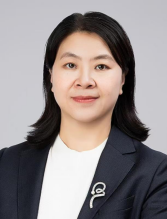CCF@U1172:CCF生物信息学专委走进大湾区大学
CCF走进高校第1172场
敬请关注
由中国计算机学会(CCF)主办,CCF生物信息学专委、大湾区大学承办的CCF走进高校活动,将于2024年11月23日在大湾区大学(松山湖校区)召开,敬请关注。
活动时间:2024年11月23日(星期六)15:00-18:00
活动地点:广东省东莞市大湾区大学松山湖校区实验楼3号会议室
活动日程:
15:00-15:10 介绍大湾区大学筹备情况
15:10-15:40
特邀讲者:李敏,CCF杰出会员,中南大学二级教授
演讲题目:3D genome: from computational methods to applications in disease
15:40-16:10
特邀讲者:张法,CCF高级会员,北京理工大学教授
演讲题目:基于人工智能的医学多模态数据融合分析
16:20-16:50
特邀讲者:陈河兵,军事医学研究院副研究员
演讲题目:3DDAS: Unveiling the Role of 3D Chromatin Structure in DNA Double-Strand Breaks
16:50-17:20
特邀讲者:崔学峰,CCF高级会员,山东大学教授
演讲题目:Advancing a Unified Deep Learning Framework for Peptide and Molecule Mass Spectrometry
报告信息:
报告题目:3D genome: from computational methods to applications in disease
报告摘要:Chromosome Conformation Capture (3C) based technologies, such as 3C, 4C, 5C, Hi-C, ChiA-PET and HiChlP, have characterized the architecture of 3D genome. However, limited by the expense and time cost of wet lab experiment, it is a great challenge to explore the chromosome contacts of unrecognized cell line or species. This talk will overview different technologies for 3D genome and present some computational solutions to explore genomic 3D organization. This talk will also introduce some of our recent work for calling targeted 3D chromatin loops.
嘉宾简介:
李敏,中南大学二级教授,博士生导师,计算机学院院长,国家“杰青”获得者,主要从事生物信息与数字健康方面研究,主持国家重点研发计划课题、国家自然科学基金重点、杰青、优青、面上等项目十余项,在Nature Communications、Genome Research、Genome Biology、Nucleic Acids Research、Bioinformatics等国际期刊和国际会议上发表学术论文100余篇,谷歌学术引用1.3万余次,H指数61,入选计算机科学领域中国高被引学者。研究成果在医学、药学、病毒学等十余个领域得到应用。担任多个国际会议的程序委员会主席和国际期刊编委,获得第十九届中国青年女科学家奖、教育部自然科学奖、湖南省自然科学奖、吴文俊人工智能自然科学奖等。
报告题目:基于人工智能的医学多模态数据融合分析
报告摘要:近年来,结合影像、病理和分子等多模态数据的综合诊断方法为肿瘤精准医疗提供了全新的发展机遇,但是不同模态数据的异质性为数据的融合分析提出了严峻的挑战。此外,现有模型未能充分利用神经网络强大的表示学习能力,无法有效地融合医学影像、病理图像和基因数据的多模态特征。本报告将介绍我们在多模态医学数据融合分析方面的研究工作,主要包括基于病理图像的深度分析,结合疾病影像数据和组学数据,根据多模态医学数据的特征与层次关系,围绕疾病生存风险分析和分子标志物预测方面的研究。
嘉宾简介:
张法,北京理工大学长聘教授,中科院计算所客座研究员,博士生导师。现任IEEE 计算生命科学专委会 (TCCLS)主席,CCF生物信息学专委会副主任。主要从事生物信息学、多模态生物医学数据处理等方面的研究:研发了国内首款冷冻电镜三维重构软件-AuTOM,解析了多个生物大分子高分辨结构;开发了系列医学病理图像分类分级AI处理技术,相关研究成果已在多家医院应用。作为项目负责人和主要参与人承担了多项科技部重点研发专项、国家自然科学基金重点、国际合作重大等项目。在Cell Research、Natural Communication、Sciences Advances、Genome Biology等国际期刊和ICCV、ISMB、MICCAI等顶级国际会议发表论文160余篇,获得MICCAI 2022 Best Paper。
报告题目:3DDAS: Unveiling the Role of 3D Chromatin Structure in DNA Double-Strand Breaks
报告摘要:DNA double-strand breaks (DSB), one of the most serious types of damage to the genome. Efforts have been made to explain the general patterns observed in DSBs. However, the contribution of 3D chromatin spatial conformation to DSB formation upon the genome remains poorly understood. Existing AI-based methods for predicting DSBs have limitations and fall short in explaining how the 3D structure of chromatin influences DSB occurrence. To address these shortcomings, we introduce the 3D-Genome Damage Analysis Framework (3DDAS). Utilizing standardized datasets, 3DDAS constructs a genome-wide DSB prediction model named Hi-DSB. From a three-dimensional perspective, we annotate key genomic features identified by Hi-DSB and measure the impact of 3D chromatin interaction density on DSB susceptibility. Additionally, we apply the critical genomic loci identified by 3DDAS to recognize oncogenes and tumor suppressor genes pertinent to breast cancer patient survival outcomes. This framework provides a novel paradigm for investigating the relationship between chromatin structure, genomic stability, and cancer progression.
嘉宾简介:
陈河兵,军事医学研究院副研究员。清华大学自动化系本科,军事医学科学院生物信息学博士,主要研究染色质结构和基因表达调控,运用深度学习等方法开发三维基因组计算方法并加以应用。作为负责人承担国自然优秀青年基金、面上项目、青年项目以及军委科技委重点项目等多项课题,成果发表在Nature Machine Intelligence、Journal of Clinical Investigation、Trends in Genetics、Genome Research 、Nature Communications、Advanced Science、Genome Biology等期刊。入选全军青年科技英才、北京市科技新星,获得叶剑英英才奖,2024年获批国家自然科学基金优秀青年基金(信息学部)。担任中国人工智能学会生物信息学与人工生命专业委员会秘书长、中国自动化学会智能健康与生物信息专业委员会委员,Quantitative Biology期刊特邀编辑。
报告题目:Advancing Biomarker Discovery with Deep Learning and Mass Spectrometry
报告摘要:Tandem Mass Spectrometry (MS/MS) is essential for biomarker discovery. It identifies proteins in proteomics, characterizes glycans in glycomics, and profiles small molecules in metabolomics. MS/MS also plays a vital role in disease diagnosis, drug development, and vaccine research. However, researchers face significant challenges affecting its effectiveness.
First, the increasing volume of peptide MS/MS spectra data demands the development of novel computational methods for swift database searches. We present MS2VEC, an innovative fingerprint embedding model designed for extensive peptide MS/MS spectra library retrieval. This model identifies the relationships between distant peaks and integrates position-sensitive fingerprint features. To achieve this, dilated convolutions are used to capture distant associations, and a position-sensitive multi-head attention pooling mechanism is applied to extract fingerprint features.
Due to the scarcity of small molecule MS/MS spectral data, conventional techniques that depend on database comparisons are inadequate for newly identified molecules that are not yet included in the database. To overcome this challenge, we present MS2SMILES, an innovative method that treats hydrogen atoms as implicitly bonded to heavy atoms. This approach is tailored to precisely predict hydrogen atoms in chemical structures, which are not explicitly shown in SMILES.
Finally, analyzing glycopeptides via mass spectrometry reveals glycan structures crucial for protein function. Introducing MS2Glycan, a deep learning framework, we iteratively construct glycan structures from data. This approach models generation as a sequence of component additions, using localization and classification tasks. GlycanGen improves prediction by using data-driven methods for component placement, overcoming rule-based limitations.
嘉宾简介:
崔学峰,现担任山东大学计算机科学与技术学院的教授兼中国计算机学会生物信息学专业委员会秘书长。他在加拿大滑铁卢大学大卫·R·切瑞顿计算机科学学院完成了从本科到博士的全部学业,之后在KAUST担任博士后研究员,并在清华大学交叉信息研究院取得了终身教授轨助理教授职位。崔教授的研究专长是生物信息学,专注于利用机器学习与并行算法解决生物科学领域的实际问题,他因此获得了2019年的ACM SIGBIO新星奖。
CCF微信公众号,欢迎关注
 返回首页
返回首页













